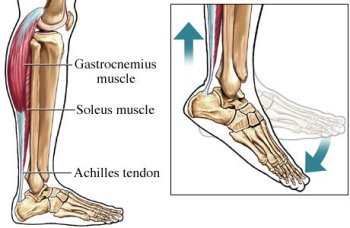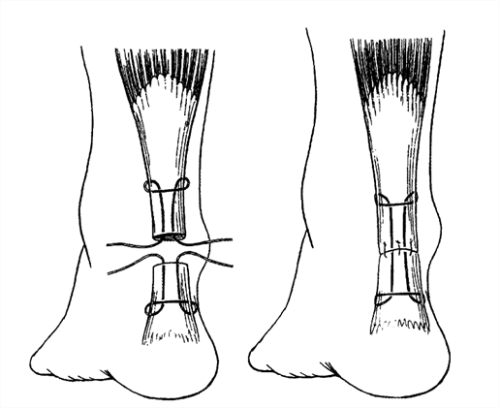Your Achilles tendons, connecting your heel bones (calcaneus) to your back calf muscles (gastrocnemius and soleus), are the longest and strongest tendons in your body. The Achilles tendons and calf muscles work together so you can perform activities such as running, jumping, standing on tip-toes, and climbing up stairs.
The tendons allow you to lift your heels and push up your toes whilst walking. The ankle motion needed for walking and running is very tricky without intact Achilles tendons.

When Is Achilles Tendon Surgery Required?
Achilles Tendon Rupture
After Achilles rupture, surgery can reattach the ends of the tendon. This procedure has been shown to reduce the chances of re-rupture as compared with immobilization (stopping your leg moving using a cast or other method).
The best results are achieved when surgery is performed fairly soon following injury, but when the inflammation has decreased, normally 4-6 weeks after the accident. However, recovery from the operation may take several months. To aid healing and regain strength in the affected muscles and tendon, a rehabilitation program will usually be needed.
Achilles Tendinopathy
Surgery isn't normally required to treat this condition. However, on rare occasions, for instance if the tendon sheath (the tissue covering the tendon) has thickened and become fibrous due to rubbing, an operation may be required. This will typically involve removing the thickened tissue and repairing any small tears that have developed to prevent the damaged Achilles tendon from rupturing.
Achilles Tendon Surgery Options
 To treat a ruptured Achilles tendon, surgeons can perform one of two types of operation:
To treat a ruptured Achilles tendon, surgeons can perform one of two types of operation:
- Open surgery. A single large incision is made in the back of the leg.
- Percutaneous surgery. Here, several smaller incisions are made instead of one large one.
The surgeons may wait a week following the injury to allow the swelling to decrease. Both kinds of operation involve the surgeon sewing the tendon back together through the incisions.
What to Expect After Surgery
For 6-12 weeks following Achilles tendon surgery, you will normally be required to wear a cast, walking boot, or other immobilization device. This will usually be positioned pointing downwards, so the foot is flexed to start with whilst the tendon heals. The devise is then slowly adjusted so the foot ends up in a neutral position (neither flexed nor extended). You'll usually be advised to start your movement and weight-bearing exercises soon, prior to removal of the cast/boot. You can expect your tendon to be fully healed in about six months.
How Well It Works
Both percutaneous and open surgery are generally successful procedures - over 80% patients are able to resume pre-injury activities, including sports. It can be tricky to compare surgical methods, as there are many factors involved, including age of the patient and extent of the injury. Other variables include the time between injury and surgery, the experience of your surgeon, the exact type of operation, and the timing of and adherence to the rehabilitation program. Speak to your surgeon, so you can assess whether he or she has the experience and knowledge needed to treat your injury.
Risks
There are several risks involved in Achilles tendon surgery, including:
- Skin infections at the incision site(s)
- The usual surgical and anesthetic risks, including drug side-effects and excess bleeding
- Damage to your nerves
- Reduced range of motion
- A weakened tendon
- Risk of re-rupture (although this is less than other treatments)
- Pain
- Delays in wound healing
- Scarring
Open surgery may increase your risk of infection compared with percutaneous surgery. However, the chances of the other complications are about the same. The majority of complications get better with time.
How Long Does It Take to Recover from Achilles Tendon Rupture?
Completely breakage of the Achilles tendon is a serious injury, and rehabilitation will take a while – around 6-9 months, depending on the extent of the trauma. Luckily, you can still do some form of physical activity while you are waiting for your ankle to heal. Talk to your physician about exercises that won't stress your Achilles tendon, for example swimming.
It's important not to rush your rehabilitation after Achilles tendon surgery, as this risks long-term disability and pain. Remember, you won't be able to resume your previous level of exercise until:
- Your injured leg moves as freely and easily as your unaffected leg.
- Your affected leg feels as strong as the other leg.
- There is no leg pain when you walk, run, or jump.
What About Other Treatments?
There are other types of treatment aside form Achilles tendon surgery that are commonly used for Achilles tendinopathy or rupture. Prior to starting these treatments, your medical professional will usually advise you to try to decrease the pain and swelling with rest and medication.
For Achilles Tendon Rupture
To immobilize the ankle and lower leg (prevent it from moving), you can have a cast or similar devise put on. For complete tendon healing, you may need to wear the cast for up to six months. A rehabilitation regime, usually involving physiotherapy, will then be required to redevelop strength and flexibility in the leg and tendon.
For Achilles Tendinopathy
To treat this condition, physical therapies can be implemented, including the following:
- Ultrasound heat therapy
- Stretching/flexibility drills
- Wearing a night brace
- Deep massage – this boosts blood circulation in your leg and develops flexibility
If your pain doesn't improve after physical therapy, you may need to use a cast or similar device for 4-6 weeks to allow the tendon to heal. When this treatment is over, physical therapy and activity modification can be used to continue the rehabilitation.
